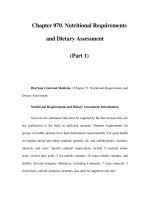Assessment task 1 BSBPMG521
Bạn đang xem bản rút gọn của tài liệu. Xem và tải ngay bản đầy đủ của tài liệu tại đây (56.3 KB, 5 trang )
Assessment Task 1 Cover Sheet
Student Declaration
To be filled out and submitted with assessment responses
I declare that this task is all my own work and I have not cheated or plagiarised the work or colluded with any
other student(s).
I understand that if I If I am found to have plagiarised, cheated or colluded, action will be taken against me
according to the process explained to me.
I have correctly referenced all resources and reference texts throughout these assessment tasks.
Student name
Student ID number
Student signature
Date
Assessor declaration
I hereby certify that this student has been assessed by me and that the assessment has been carried out according
to the required assessment procedures.
Assessor name
Assessor signature
Date
Assessment outcome
S
NS
DNS
Resubmission Y
Feedback
Student result response
My performance in this assessment task has been discussed and explained to me.
I would like to appeal this assessment decision.
Student signature
Date
N
Task 1: Written questions
Provide answers to all of the questions below:
1.
Explain project governance.
The concept of project governance covers rules and regulations used to execute a successful project
and introduce procedures to ensure compliance with these standards for proper functioning of the
project. The rules and regulations will correspond with the project objectives and be in line with any
relevant industry standards and/or regulatory provisions.
2.
Summarise two project governance models and explain one advantage and disadvantage of each.
•
Steering group – This group takes charge of reviewing the progress of the project at
specified intervals to ensure compliance to the governance plan of the project. The
advantage of this model is that it provides a way of getting everyone on the same
page by communicating information to all parties at the same time and in the same
way.
Disadvantage associated with this model is that it shows less or even lack of
effectiveness
•
Management group – using this model, members of the group will be take
responsibilities for compliance to project governance on a practical, day to day basis
such as logistical issues, conflict resolution, communications, progress reports and
may involve managers of: overall project, communications, procurement. The key
advantage associated with this model is that it enables stronger team dynamics as a
whole throughout the organization
However, this model lack of productivity.
3.
Describe the purpose of a Work breakdown structure and the key steps involved in creating a Work breakdown
structure.
The purpose of a WBS is to organise and devide the project into smaller, manageable sections for the
purpose of seeking the essential resources needed to complete activity and to assign on roles and
responsibilities for each team and member of the project so everyone can be clear about what to do
next in the process and the project. Therefore, identifying who will complete the work, how, and when
to do it will need to be broken into multiple smaller sub-projects and sections in order to support this
objective
The key steps involved in creating a Work breakdown structure.
- To analyze the actions of people to minimize the likelihood of workers from conflicts, to determine
the opportunities for improvement
- To identify the targets for achieving this outcome
- To track the progression of actions aimed at improving productivity and in the system to re-establish
working conditions in a reasonable time frame.
- The process of turning the "process of analysis" into a "process of utilization" is important. If this
step is not mastered then there is little chance of the Productive Planning process meeting its goals.
- It is a visible diagram, the structure of decomposition in organizational reality ensures that
subordinates know their own roles and responsibilities. It also allows you to identify potential risks in
each section and establish contingency plans in case the risk is realized.
4.
Describe the concept of decomposition in project management and its role in breaking project objectives into
achievable project deliverables.
Project decomposition is a technique which are employed to to break deliverables progressively into
smaller parts. The WBS is positioned as the top layer encompassing the decomposition.
Deliverables are oriented hierarchical decomposition of the work to be executed by the team to achieve
the project objectives and form the required deliverables. The concept of decomposition can be thus
briefly described as to put in pieces all the deliverables in little part.
5.
Explain the role of the project management life cycle in project management and describe each key phase.
•
•
•
•
6.
Initiating: Project Charter
Planning: Project Plan
Executing /monitoring and controlling: Performance reports, risk identification, risk
management…
Closing: User acceptance, final reports, documents, lessons learned.
Assume that you have been appointed as Project Manager of a firm of lawyers based in Sydney who wishes to
establish an additional office in Melbourne. A timeline of 3 months is given plus maximum budget of $20,000 rent
per month for the new office.
Explain each part of the project life cycle relevant to this project and provide an outline of an
appropriate project governance structure.
Initiating: Identifying an opportunity to satisfy the Melbourne huge demand found by researches and
surveys
Plan: Find property, budget, materials, reception all the deliverables
Do: Go to Melbourne; search for a local real estate; chose a good venue; sign the contract; furnish the
office; hiring new employees and moving some from Sydney; search marketing, located property,
search for technology.
Closing: open new office in that city, celebration, looking for feedback
How to manage this new office in Melbourne: Meeting 2 weeks a month
7.
Identify and describe two organisational documents that can be used to record strategies and goals for project
integration.
•
Project charter: is a formal, typically short document that describes your project in its entirety —
including what the objectives are, a detailed list of associated requirements and how the project
objectives will be carried out, a project overview, a business case with the identification of
stakeholders. It is a design document that lists the overall project and describes each part. It will
guide the development of the design phase, and contains information that is critical to the project,
like staff and funding availability. Project charter should be broad and inclusive, giving a detailed
description of the problem instatement, business need, smart goal, its scope, mission, objectives,
and milestones. Project charter is a crucial ingredient in planning out the project because it is used
throughout the project lifecycle.
Project title:
Date:
Problem statement:
Business need:
Smart goal:
Scope team:
Milestones:
Budget:
•
Project initiation document is one of the most critical elements of project management, which
establishes the foundation for a project.
Project goal(s): this sets out what do you want to achieve for the project?
Project size: this deals with how large is the project, how long it takes and how many people are
involved?
Project organisation; who are involved in the project, what are their tasks, responsibilities and
authority?
Limits and risks; what can cause a project to stagnate and are there risks related to the project?
Stakeholders; who has a stake in the success of the project?
Project checks and frame reporting.
8.
Describe how a project scope management plan assists with recording strategies and goals for project integration
processes.
The scope management plan is desighed to decide on who is responsible for managing scope, how it is measured
and verified and the procedures for scope changes. The schedule management plan determines the coordination and
control of program activities for the production and documentation of work. It establishes the steps to be followed
by supervisors in implementing assigned changes. It also provides details of the overall framework for the project
schedule, the way to allocate resources, timeframes for project activities, roles and responsibilities for the
accomplishment of deliverables and milestones, and proposed measures of project performance. Project scope is
establised in line with the project objectives, also all project activities and deliverables must be aligned with the
objectives.
Project scope must have an integrated control.
Project scope should be reviewed and verified by stakeholders at regular intervals, such as on completion of key
deliverables and project milestones, to ensure that deliverables are in line with objectives and irrelevant deliverables
are not being produced. This becomes especially important with respect to those deliverables that have a significant
and disproportionate impact on the project timeline, such as the scope of contract services, engagement and design
of solutions. A project scope should be reviewed and verified at the beginning of each project to ensure that the
scope is accurate and consistent with any documentation, implementation guidance, or contractual requirements.
The scope should be validated for each successive iteration of the project based on an understanding of the
information provided.









